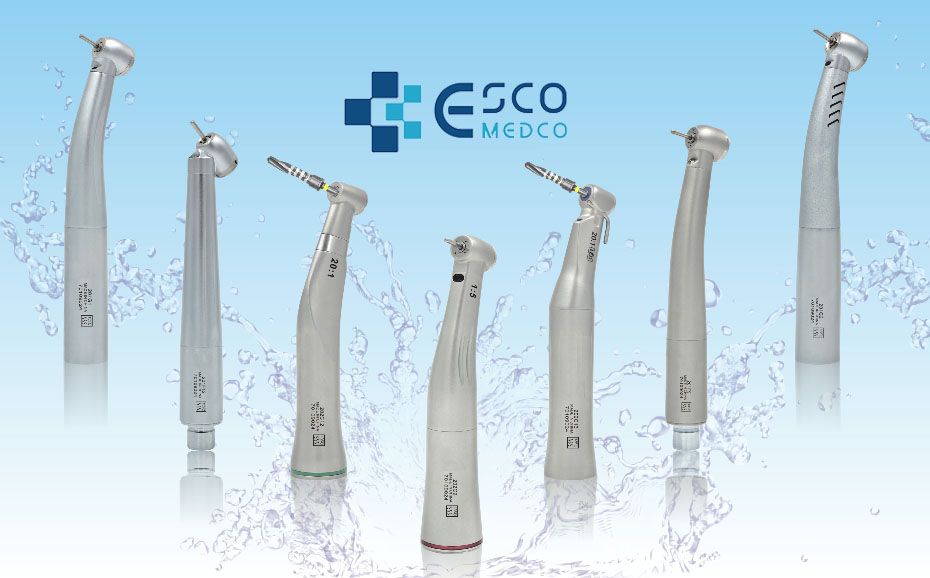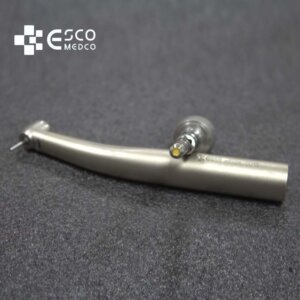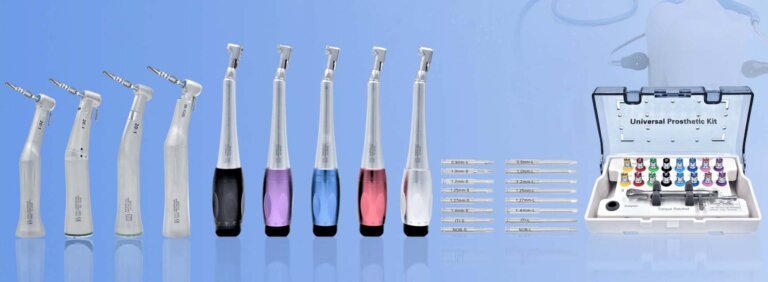Dental Handpiece Types: Complete Guide to Air, Electric & More
More worry free / Less effort / More competitive
Dental handpieces are one of the most common core tools used by dentists in dental practice. Among the various dental handpiece types, classifications are typically based on their intended purpose and drive method. Common dental handpiece types include high-speed handpieces, low-speed handpieces, electric handpieces, pneumatic handpieces, implant handpieces, and root canal handpieces. Each type differs in structure, rotational speed, and clinical application to meet diverse treatment needs.
Table of Contents
Traditional Dental Handpieces
At the forefront are two main types of dental handpieces introduced in the late 1860s and early 1870s – these are pneumatic and electric dental handpieces – both of which have their specialties, benefits, and drawbacks. As you might expect, the significant differences between the two types of dental handpieces are also related to the types of add-ons or attachments available for each variant. Understandably, the accessories used on electric dental handpieces are not compatible with pneumatic models. If you’re wondering which type is better, alas, this question cannot be answered directly. A survey with several dentists will yield different results. Simply put, preferring one type of dental handpiece over another is a matter of personal preference and varies from case to case.
For now, let’s take a closer look at the two traditional types of dental handpieces to learn more about the pros and cons of each variant.
Air turbine dental handpieces
1. What Are Air Turbine Dental Handpieces?
As the name implies, air turbine dental handpieces operate using high-speed compressed air, which drives a turbine to rotate the cutting instrument. This mechanism enables fast and efficient dental procedures, especially for removing decayed or damaged tooth structure.
2. Why Are They So Widely Used?
Air turbine handpieces are among the most commonly used dental tools worldwide. Their popularity can be attributed to two main factors:
Cost-effectiveness: They are generally more affordable than other types of dental handpieces.
Low maintenance requirements: Simple structure and air-driven design mean fewer parts that can wear out or fail.
3. Advantages of Air Turbine Handpieces
High rotational speed: These handpieces can reach up to 400,000 revolutions per minute (rpm), although the recommended operational speed is about 300,000 rpm.
Powerful performance: Capable of rapidly cutting through tooth material with ease.
Lightweight and compact design: This makes them easy for dentists to handle and precisely position within the patient’s mouth, enhancing comfort and control during procedures.
4. Main Limitation: Low Torque
Despite their speed and convenience, air turbine handpieces have a significant drawback—low torque.
What does this mean? Torque is the ability to maintain speed under resistance.
When faced with harder materials or heavier pressure, the handpiece may lose speed dramatically.
For example, a unit running at 300,000 rpm can drop to around 170,000 rpm upon contacting a solid surface due to increased resistance.
Clinical implication: This loss of speed can affect cutting efficiency and may require the dentist to apply more time or adjust technique.

Motorized dental handpieces
1. What Are Electric Dental Handpieces?
Unlike air turbine handpieces, electric dental handpieces are powered by a high-speed electric motor connected to a mains electricity supply. This design provides dentists with greater precision, control, and consistent torque throughout procedures.
2. Speed and Power Performance
Typical Speed Range: Most electric handpieces operate at speeds below 200,000 rpm, with 200,000 rpm being a common average on the market.
While they don’t reach the ultra-high speeds of air turbines, electric handpieces deliver consistent and powerful torque, even under heavy load.
Optional speed upgrades: Certain models can reach higher speeds when combined with speed-increasing attachments, enhancing their functionality further.
3. Key Advantages of Electric Handpieces
✅ Constant Torque & Stable Cutting Power
Electric motors maintain a steady rotational force, making them ideal for cutting dense tooth structures, removing crowns or bridges, and performing surgical or restorative procedures.✅ Versatility
A wide range of attachments and contra-angles can be used to customize the handpiece for various applications:High- and low-speed restorative work
Endodontic treatments
Oral surgeries
Dental lab work
✅ Reduced Noise and Risk
Since electric handpieces do not use air pressure, they are:Quieter in operation, improving patient comfort
Safer in surgical environments, eliminating the risk of air embolism during invasive procedures
✅ Greater Control with Minimal Pressure
The steady torque output allows dentists to perform cuts with less physical pressure, enhancing control and reducing hand fatigue. However, clinicians accustomed to air turbines should first adjust their technique, as heavy-handed use may lead to overcutting.
4. Clinical Applications
Electric handpieces are especially well-suited for:
Tooth preparations requiring consistent torque
Removal of delicate restorations like crowns and bridges
Precision-based procedures such as endodontics or prosthodontics
Soft-tissue surgeries where control and safety are paramount
5. Limitations to Consider
Despite their many benefits, electric dental handpieces do come with some trade-offs:
⚠️ Overheating Risk: Extended use or poor cooling can cause the handpiece to overheat. In extreme cases, this has led to severe burns in patients.
⚠️ Heavier Weight: The built-in motor makes electric handpieces bulkier and heavier than air turbines, which may affect maneuverability for some clinicians.
⚠️ Complex Configuration: Due to their more intricate design and setup, these handpieces may require additional training and adjustment time, especially for practitioners used to simpler air-driven models.
Dental Handpiece Subcategories
Beyond the two primary categories—air turbine and electric dental handpieces—there are several important subcategories and specialized accessories that can help clinicians choose the right tool for specific dental procedures. These variations are designed to improve maneuverability, precision, and efficiency in different clinical scenarios.
1. Curved Dental Handpieces
Curved handpieces feature an angled or bent shaft, designed specifically for enhanced maneuverability in hard-to-reach areas of the oral cavity.
Advantages
Improved access to posterior teeth and other difficult-to-reach zones
Better visibility and control in narrow or angled spaces
Useful for specialized endodontic and surgical procedures
Limitations
Not suitable for high-speed cutting
May require additional training for optimal handling
Common Applications
Accessing molars during root canal therapy
Subgingival procedures
Pediatric dentistry where smaller spaces are involved

2. High-Speed Dental Handpieces
High-speed or ultra-high-speed dental handpieces typically operate at speeds up to 800,000 rpm, and are often air-turbine driven. These handpieces are equipped with a cooling water spray system to prevent overheating.
Key Features
Ultra-fast rotation for efficient tooth structure removal
Water jet system to cool both tooth and instrument
Optional fiber optic lighting or laser guidance for precision
Advantages
Ideal for cutting enamel, crowns, and restorations
Reduced procedure time due to high rotational speed
Enhanced visibility with built-in LED/fiber optics
Limitations
Lower torque (especially in air-driven models)
May generate high-pitched noise, causing discomfort to patients
Less effective when cutting through harder materials compared to electric handpieces
Common Applications
Cavity preparation
Crown cutting
Removal of old fillings
Cosmetic contouring
3. Low-Speed Dental Handpieces
Low-speed dental handpieces operate at speeds between 6,000 to 10,000 rpm. They provide stable torque and are primarily used for finishing tasks, not for cutting hard materials.
Key Features
Slower rotation for delicate and precise operations
Often motor-driven for better torque consistency
Can be used with polishing attachments or prophy angles
Advantages
Greater control during polishing or finishing
Safer for soft tissue contact
Low noise level
Limitations
Not suitable for cutting or drilling
Less efficient in time-sensitive procedures
Common Applications
Prophylaxis (tooth cleaning)
Finishing and polishing restorations
Adjusting acrylic prosthetics
Orthodontic bracket removal
4. Dental Handpiece Accessories and Add-Ons
Modern handpieces can be customized or upgraded using various attachments that enhance performance and expand functionality.
Common Attachments
| Accessory | Function | Benefit |
|---|---|---|
| LED Light Attachments | Built-in or external light source | Improves visibility, especially in deep or shadowed areas |
| 360° Swivel Heads | Allows the handpiece to rotate freely | Enhances maneuverability and reduces wrist strain |
| Curved Attachments | Adds a bend to standard handpieces | Enables better access to difficult areas |
Advantages
Extends the handpiece’s clinical utility
Allows customization for varied procedures and techniques
Improves ergonomics and comfort for the operator
Limitations
Adds cost and maintenance complexity
Compatibility varies by brand and model

- dental handpiece types
Choosing the right dental handpiece type is crucial for ensuring precision, efficiency, and patient comfort across various dental procedures. From high-speed air turbines ideal for rapid cutting, to electric handpieces offering constant torque and control, and specialized subtypes like curved or low-speed handpieces tailored for polishing and delicate work—each variant plays a unique role in modern dentistry. By understanding the strengths, limitations, and ideal applications of each type, dental professionals can make informed decisions that enhance clinical outcomes and optimize their workflow. As technology continues to advance, dental handpieces will only become more versatile and integral to delivering high-quality patient care.
Related Dental Products
How Can We Help?
START YOUR DENTAL MEDICAL INSTRUMENT ONE-STOP PURCHASING JOURNEY








